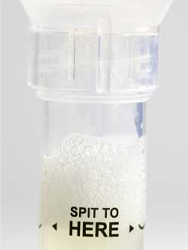Over the years we have expanded the scope of our practice to focus on the oral systemic connection. This is the link between our mouths and our bodies. Now we can see signs of common systemic illnesses such as Type 2 diabetes, sleep apnea, acid reflux, hypertension, heart disease, and oral cancer. Historically, a true oral cancer diagnosis comes with an invasive procedure — a tissue biopsy cut from the mouth and analyzed using a microscope. If you are diagnosed with oral cancer, you have about a 50/50 chance of survival. To date, science has made little progress with that ratio. But what if we could detect oral cancer and other systemic cancers much earlier, simply by spitting in a cup?

Your Saliva and Science
Salivary diagnostics are currently being used in dental offices to detect the genetic predisposition for periodontal disease and heart disease. Add to that the ability to screen for HPV (Human Papillomavirus) infection — the virus that is linked to oral and pharyngeal cancer. Science and industry have brought forth this amazing tool that can analyze a drop of saliva to identify telltale “biomarkers” of cancer and other systemic diseases at their earliest stages. With HPV screening, we can detect an active viral infection and begin the discussion on how to prevent its progression to cancer.
HPV oral infection is increasing 30% per year, and yet for those of us in the dental community, initiating conversation with our patients about this topic can still sometimes be uncomfortable. This screening process requires a frank discussion about their sexual habits and risks. HPV is the #1 most rampant STD, transmitted primarily through oral sex. And while we struggle with what words to say and warnings to share, the HPV epidemic continues to proliferate before our eyes. Oral HPV infection is detectable in a single drop of saliva, and about 25% of people test positive for at least one HPV strain. Continued exposure to infection can ultimately lead to cancer. Unlike some viruses (like Herpes and HIV), human beings are able to “clear” an HPV infection, provided they work toward optimal “host immune response” or peak overall health.
But using these tests comes with a word of caution. They will detect an oral HPV infection, which around 26 million Americans have on any given day. However, this is not an indicator that a person will develop cancer. In fact, only about 1% of individuals that have the high risk oral HPV infection will ever develop cancer, and that most often occurs decades later. The best way to screen for HPV-related oral and pharyngeal cancer is still through a visual and tactile exam given by a medical or dental professional. In conjunction with this exam, a thorough medical history assessment that asks about risks and habits helps to identify things that are not visible or palpable. This is why our goal is to detect a positive HPV infection early, before it turns into cancer. The way we do this begins by having open dialogue with our patients. If this discussion reveals a lifestyle that places a patient in a higher risk category, then we’d offer salivary diagnostic testing for HPV. This testing can shed more light on their current health, and hopefully empower them to take action in preventing cancer.
What’s Ahead
The future of saliva testing for diseases other than cancer is also very promising, and will eventually aid in early detection of Alzheimer’s disease, Type 2 diabetes, arthritis, Sjorgren’s Syndrome, and more. While salivary diagnostics are a great tool, what must come first is open and honest discussion between doctor and patient. When this occurs, it can be the most important step a person takes on their health journey. Things like HPV-related cancer can be prevented. That’s something that is exciting to those of us in the dental community!
